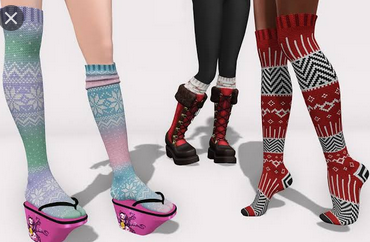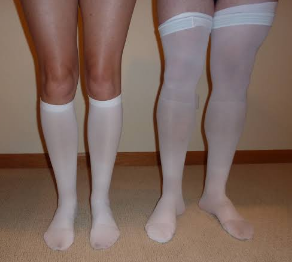Compression socks are designed for standing or walking, to help the veins conduct blood up to the heart.
They are not recommended for wearing to bed for long periods.
We normally sleep horizontally, with our feet at the same level as our hearts.
Returning blood back to the heart at a higher rate can result in complications.
Types of Compression Socks with Different Compression Levels

Various sizes and colors of compression stockings are available for you to make a choice. Here are the types of stockings you may need:
- Mild Compression Socks – made for relieving minor symptoms in the body. They offer the lowest level of compression with 8 – 15 millimeters of mercury (mm-Hg).
- Medium Compression Socks – suitable for persons that like wearing them on a regular basis. It is also known as the beginners choice. The level of compression is 15 – 20 millimeters of mercury (mm-Hg).
- Firm Compression Socks – offer tight and firm level of compression of 20 – 30 millimeters of mercury (mm Hg).
- Extra Firm Compression Socks – provides extra level of compression and firmness with 30 – 40 millimeters of mercury (mm-Hg).
- RX Compression Socks – you can only wear this type of socks if prescribed by a physician. RX socks are used for handling severe issues in the veins and arteries.
Other classifications of compression socks include
Anti-embolism Compression socks

Patients that cannot use their legs require anti-embolism compression socks. They reduce the effects of deep vein thrombosis (DVT).
The level of compression varies. This type of stockings offer gradient compression like graduated socks. By wearing it, you will feel less pressure in your legs and ankles.
Non-medical Support Compression Socks and Hosiery
Flight socks and elastic support hoses are among those classified as non-medical support socks and hosiery. They are suitable for relieving pains in the legs and tiredness of feet. No prescription is required for using these socks.
Graduated Compression Socks
Graduated compression socks are made to enhance mobility and suitable for professionals. You can choose the opened toe type or closed toe type.
The stockings can reduce build up of fluid in your ankles leading to swellings in the lower legs or a syndrome known as peripheral edema. They are firmer at your ankles and the strength reduces towards the knees.
These compression stockings extend to your thigh and waist. They will help in eliminating pooling of blood in your ankles and lower legs.
Why Do You Need to Wear Compression Socks?
You may need to use compression socks if you have the following conditions or symptoms in your body:
- Swellings and pains in the legs, which can be relieved by wearing these snug-fitting stockings.
- Pregnancy – compression socks help your blood vessels work better during gestation period. The arteries carrying oxygenated blood relaxes enhancing proper circulation of blood in the body.
- Surgery patients or persons confined to their beds due to illnesses.
- People with blood circulatory diseases such as deep vein thrombosis (DVT).
- Professionals that spend hours sitting or standing at a place like pilots, security personnel, and others.
Other reasons why you may need these medicated stockings include

- Better performance in sports and other aerobics.
- To improve and maintain normal blood flow in the body.
- For comfort and convenience throughout the day.
Some Health Conditions that Require Using Compression Socks
The following health conditions may require the use of medical compression socks:
Varicose or Spider Veins
Venous weakness are the major causes of varicose or spider veins. The inflamed veins are saccular and swollen with painful sensations on the affected parts. Wearing compression socks can help in relieving the symptoms of varicose veins.
Lymphedema
When the lymph fluid is unable to return to the bloodstream normally, it can accumulate in parts of the body causing inflammations. Lymphedema causes swellings in the legs, arms, neck, and belly.
Medical compression stockings can eliminate this syndrome.
Lipodermatosclerosis
When the subcutaneous fat is inflamed, it results in lipodermatosclerosis. This is a form of panniculitis and can be treated by using compression socks.
Edema
This condition results when plasma water moves from the capillaries and blood vessels into the delicate tissues of the body. Edema can be relieved by using compression socks every day.
Phlebitis
Blood clotting can occur from trauma, infection, and inflammation in the veins of a person’s legs. These symptoms are the causes of phlebitis. Patients of varicose veins can be easily affected.
Using medical socks regularly can help in handling cases of phlebitis.
Deep Vein Thrombosis
Blood clotting or thrombosis can occur when the flow of blood to and fro the lower parts of the body is reduced. This condition can cause blood and fluid to accumulate around the ankles and legs.
Get relief from this syndrome by wearing graduated compression stockings daily.
Chronic Venous Insufficiency
A patient whose veins are too weak to pump deoxygenated blood back to the heart is suffering from chronic venous insufficiency. Such person needs compression socks to improve blood circulation in the body.
The Health Conditions that Does not Require Using Compression Socks
Do you know you cannot use compression stockings if you have the following conditions?
- Peripheral artery disease.
- Massive swollen legs.
- Oozing from fragile skin caused by dermatitis.
- Skin diseases.
How Long Can Someone Use Compression Socks
A person may decide to use compression socks as long as he or she chooses. If it is prescribed by a doctor, you can use it for many years or a life time.
Various designs like compression pantyhose, dress stockings, waist attachment, thigh-high socks, maternity pantyhose, sports tights, and knee- high socks with closed toe are available on the market.
Sick persons with poor circulation may need the socks to enhance the flow of blood and maintain good health.
Depending on your needs or health conditions, you may wear medical compression socks throughout the day. This practice can relieve symptoms and aid the healing process.
Remove them before going to bed and put on again early in the morning.
Top-rated sports enthusiasts need compression socks to improve agility and performance.
Maternity pantyhose is good for pregnant women to ensure proper circulation of blood during gestation period.
No matter your condition and needs, do not wear medical compression socks to sleep on the bed throughout the night.
How to Use Compression Socks

Different sizes and colors of socks with varied compression strengths are available. Learn how to use them and maximize the benefits.
Compression socks are made for snug fitting. The doctor will determine your size. You may wear them only on one leg or both legs depending on your needs.
Two pairs of socks will be given to you, in case you want to wash and change to a clean pair if the other one is dirty.
After handwashing your stockings, dry them at a comfortable temperature. Do not apply direct heat. The temperature should not exceed forty degrees Celsius.
You can use compression socks for three months or a maximum of six months before replacing them. The doctor will measure your legs again and administer a new pair of socks to you.
This page last updated January 7, 2022
